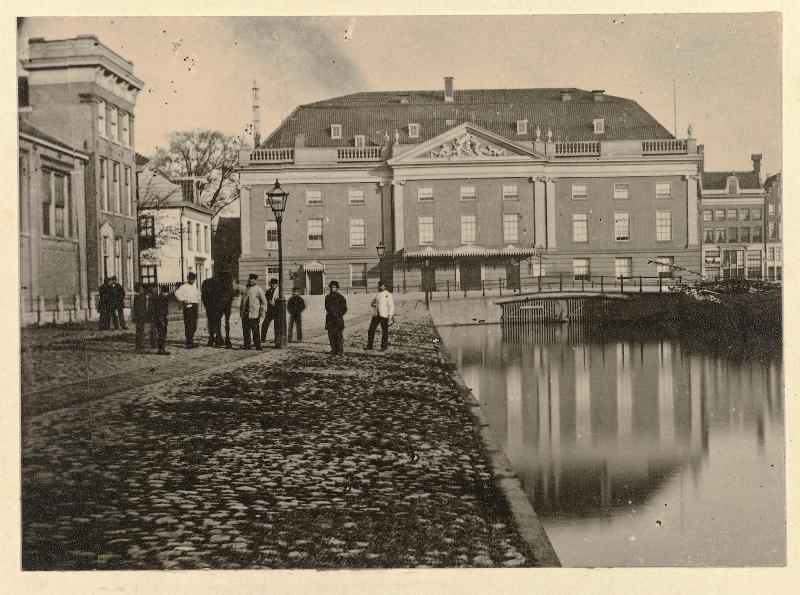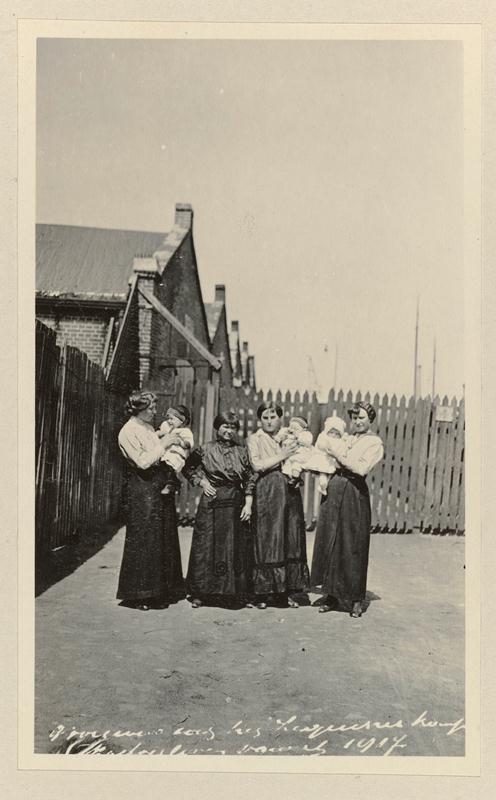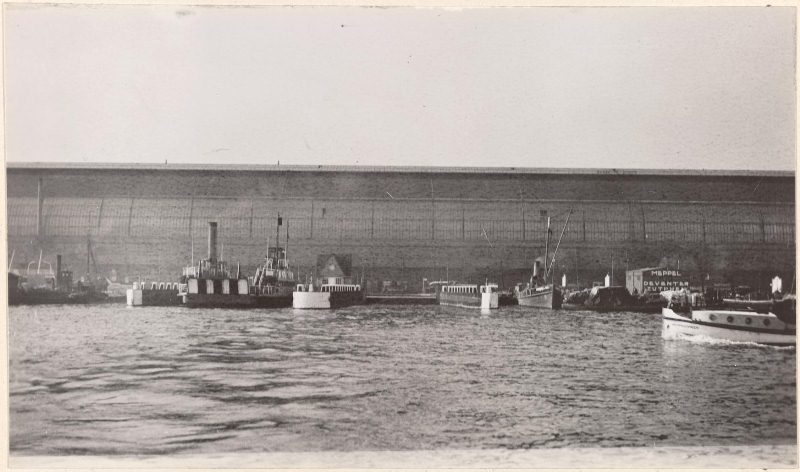Changing Amsterdam : A city photographed by Jacobus van Eck, c. 1917-1940[1]
Abstract
Jacobus van Eck (1973-1946) is mainly known as the private collector of Amsterdam topographic views (prints, drawings, maps, and some paintings). His collection also includes photographs made from c. 1880 onwards that can be considered their photographic counterparts. His main interest was the 19th century in which the outskirts of the Dutch capital quickly and radically changed as the population doubled between 1850 and 1900. As the old town – within the 17th-century walls – could no longer house this surplus, Amsterdam started developing the surroundings that had never been used systematically for building houses and other buildings. Van Eck had known these rural areas as a child and saw them change with some sense of nostalgia. However, he managed in not being overwhelmed by sadness and dislike of all things new and modern. Especially after he started making photographs himself in 1917 he not only depicted what was disappearing but also gave attention to the newly built quarters. This article explores for the first time the scope, meaning and ambitions of Van Eck’s own photographs and analyses what they add to much better and wider known photographs of Amsterdam, especially those made by Jacob Olie, George Hendrik Breitner, and Bernard Eilers. Published and unpublished documents give an insight into what Van Eck’s intentions were and how his photographs are to be seen.
Anyone wanting to learn from photographs how Amsterdam looked around 1900 will undoubtedly think first and foremost of Jacob Olie (1834-1905), George Hendrik Breitner (1857-1923, fig. 1) and Bernard Eilers (1878-1951, fig. 2). They not only made many Amsterdam cityscapes over a long period of time, but the images are considered generally as the best and most important that have been made. Therefore it comes as no surprise that for many years now these ‘big three’ have been given much more attention in the photo-historic literature than all other photographers who chose Amsterdam as their subject.[2]
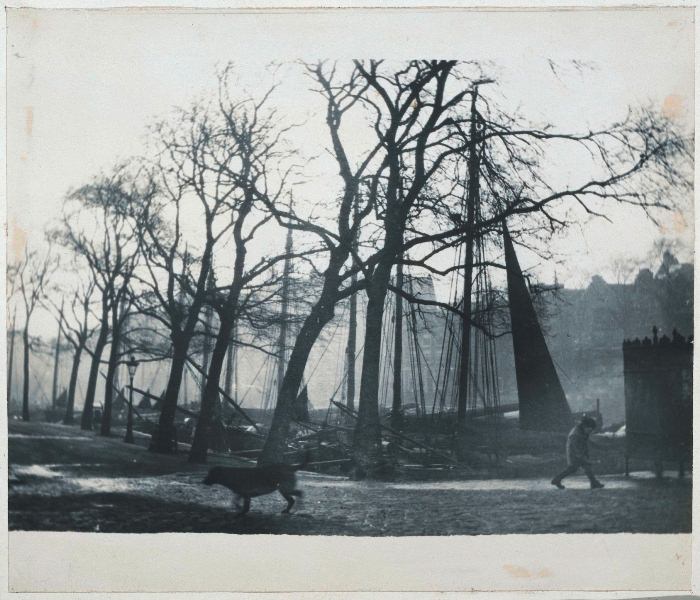 |
Fig. 1. George Hendrik Breitner, Waalseilandsgracht seen from Prins Hendrikkade, 1900-1905. Gelatin silver print, 260 x 372 mm. Amsterdam, Rijksmuseum, inv. no. RP-F-00-573. |
Our present image of ‘old Amsterdam’ is to a large degree determined by three oeuvres, some of which have a distinct personal character. Especially in Breitner’s work it is clear that his choice of subject matter and the way he depicted Amsterdam is deeply influenced by his very personal taste and vision. One will look in vain in his photographic work for certain subjects, as he deliberately chose not to include them in his cityscapes. Although Breitner was very interested in horses and horse trams, he was clearly less enchanted with the electric trams that appeared in 1900, calling them ‘ugly, soulless boxes’.[3]
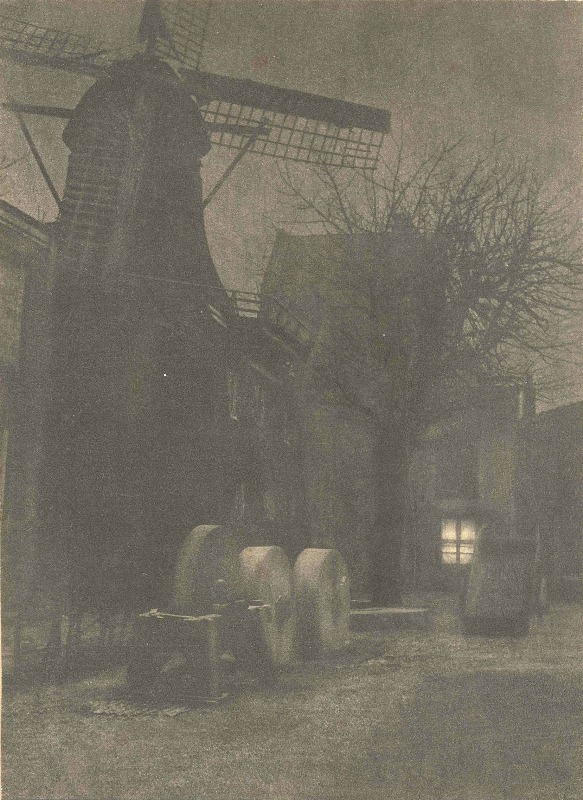 |
Fig. 2. Bernard F. Eilers, If it could be evening (windmill ‘The Victor’), 1896. Direct carbon print, 254 x 185 mm. Leiden, Leiden University Library, Special Collections, inv. no. PK-F-06.039. |
For Eilers, who as a disciple of Pictorialism wanted to render his personal impressions before anything else, Amsterdam seems to have been a mirror of his soul. The cityscape was a suitable subject for him to express his artistic vision.[4] Eilers’s photographs of Amsterdam are as much ‘coloured’ as Breitner’s. Jacob Olie sought ‘the beautiful’, and had a deep interest in the important changes that took place in Amsterdam during his lifetime.[5] His photographs seem to have been less determined by an expressly manifested vision or taste, but his work is nevertheless considered important because of his sharp eye, his mastery of photographic technique, the large number of photographs he made (several thousands) and, last but not least, the fact that he traversed the city earlier than nearly every other photographer: in the years 1861-1864 and subsequently from 1890 until shortly before he died in 1905.
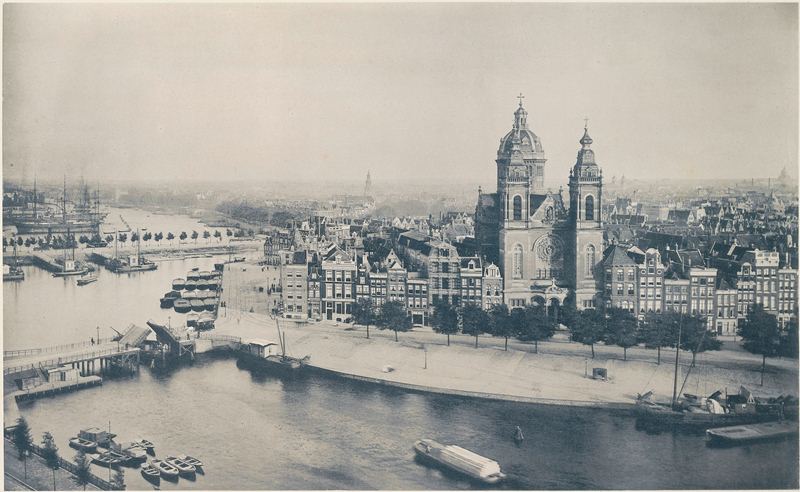 |
Fig. 3. G.H. Heinen, Prins Hendrikkade and St.-Nicolaaskerk, seen from Central Station, Amsterdam, c. 1895. Collotype, 283 x 460 mm. Amsterdam, Rijksmuseum, inv. no. RP-F-F25738-H. |
There were more photographers than these three who depicted Amsterdam around the same time. Among them were J.L. Scherpenisse (1888-1966), G.H. Heinen (1851-1930, fig. 3), Joh. Bickhoff (1881-1968), Cornelis Leenheer (1869-1942) and Jacobus van Eck (1873-1946). They have received much less attention (or no attention at all) until now.[6] That can be explained on at least two grounds. Some of these ‘minor masters’ produced only a modest body of work (some dozens, as in the case of Heinen, or several hundreds, as in the case of Scherpenisse); and sometimes the character of their photographs is much less distinct, artistic or personal.
The present article is devoted to one of these lesser known photographers. We can increase our knowledge of topographic photographs – and thus of Amsterdam as it used to be – by considering the work of people like Van Eck instead of limiting ourselves to the large and important bodies of work left by Olie, Breitner and Eilers. It is indeed possible the lesser peculiarity of ‘minor’ photographers will give us a better insight into how Amsterdam used to look, as their photographs are less determined by very personal choices.
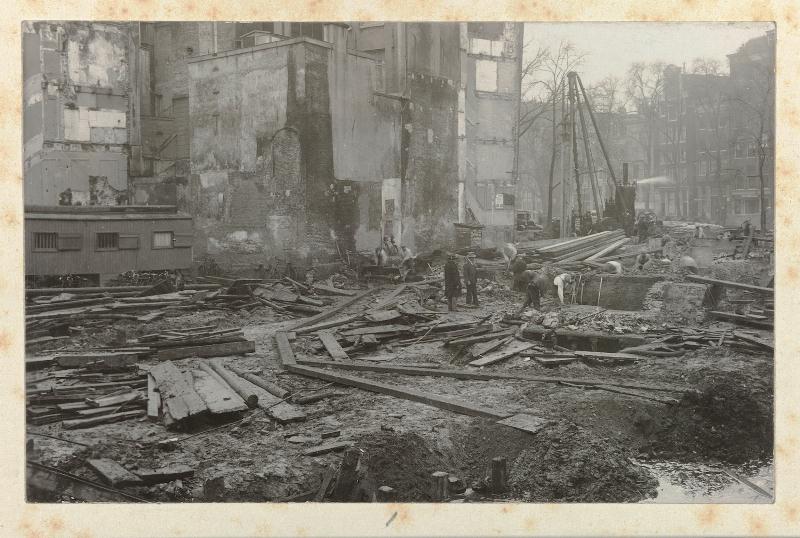 |
Fig. 4. Jacobus van Eck, Building site at Spuistraat/Paleisstraat/Singel, May, 1931. Gelatin silver print, 89 x 139 mm. Amsterdam, Koninklijk Oudheidkundig Genootschap. |
This article focuses on the photographs Jacobus van Eck made between about 1917 and 1940, years when many changes were taking place in the Amsterdam urban landscape (fig. 4). What makes Van Eck so interesting is the fact that we can find out more about the motives behind his photographic activities than is the case with most other photographers who made Amsterdam their subject in the decades around 1900. Some 1,700 photographs made by Van Eck have been preserved, all left by him to the Royal Antiquarian Society (Koninklijk Oudheidkundig Genootschap, KOG) in Amsterdam.[7]
In this article I do not want to just give a first and provisional introduction to Jacobus van Eck and his photographs, but also to try to analyze to what degree his work was influenced by personal motives and preferences, as was the case with Breitner, Olie, and Eilers.
Jacobus van Eck, collector and photographer
Van Eck not only bequeathed his photographs and negatives to the KOG, but also some 1,650 topographic drawings.[8] Van Eck was certainly not the first or only collector of topographic images of Amsterdam. On the contrary, it was a rather common activity among members of the KOG (founded in 1858).[9] Neither was he the only collector to include photographs in his collection.[10] However, the fact that he made photographs himself during many years and on a large scale does distinguish him from almost all other collectors of topographic scenes of Amsterdam.
Van Eck was born in Amsterdam in 1873 and worked as an agent handling coffee and – especially – tea. As far as we know he started his topographic collection around 1906.[11] It is very likely that he started making photographs in 1917; at least, that is the earliest date to be found on his own photographs.
Probably Van Eck has made many photographs in the first five years, from 1917 to 1922, but only relatively few in the years between 1923 and 1935. From 1936 onwards until the outbreak of World War II he again produced a larger body of work.
 |
Fig. 5. Jacobus van Eck, Slatuinenpad with a gardener’s house, 1917. Gelatin silver print, 84 x 134 mm. Amsterdam, Koninklijk Oudheidkundig Genootschap. Reproduced in Kouwenaar 1940, p. 38. |
To Van Eck collecting was not just bringing together a body of prints, drawings, maps and photographs (and a few paintings), but also gathering a large quantity of data on the major and minor changes that Amsterdam (and especially its borders) underwent between around 1877 and 1915. By then, the 17 th century city walls and gates had already long since lost their military significance, and had therefore been neglected.[12] As the defenses were demolished little by little from around 1800 onwards, they were informally replaced by an extensive, long, narrow promenade. The rapid growth of Amsterdam’s population necessitated expansion of housing: in the second half of the 19 th century the population doubled.[13] After the walls had been almost entirely dismantled, in 1877 the municipality adopted the Kalff Plan (named for the city engineer who drew it up), which prescribed how the strips of land on both sides of the old Singelgracht (the canal that had been the outer limit of the city from the 17 th century onwards) were to be turned into building plots. Until well into the 19 th century this land been occupied by private gardens, drainage ditches, farmhouses, factories, small houses, mills and public gardens. They had to make way now for planned, large-scale development consisting largely of houses (fig. 5).[14] From the last quarter of the century onwards Amsterdam received a ‘ring’ of new construction that is still there today, in neighborhoods like the Oud-West (Old West), de Pijp and the Dapperbuurt. Some 100,000 houses were built there from 1877 onwards. As a consequence the old landscape that Van Eck and his contemporaries had known so well, and that Jacob Olie had photographed since 1890, disappeared.
Demolition and Change
Van Eck very precisely chronicled all these transformations. The result was a bulky book, De Amsterdamsche Schans en de Buitensingel.[15] It describes the radical changes on both sides of the old Singelgracht. On the town side the land on and within the former defenses and the bulwarks was called the ‘Schans’, on the other side of the canal was the Buitensingel, a road more or less replaced by present-day Nassaukade, Stadhouderskade and Mauritskade. Van Eck worked on the book especially in the last years of his life, but it was printed only in 1948, two years after he died. Making use of City Council resolutions and reports from the Public Works Department, Van Eck compiled comprehensive dossiers in which he wrote up chronologically which streets were laid out, which mills were demolished, and so on.[16] These dossiers were the basis of his book. However business-like its character, the book opens with a passage which makes it clear how strongly Van Eck felt attached to the city’s old environs, the transformation of which he so meticulously described. Van Eck, born in 1873, had seen it all happening as a young boy. In the introduction to De Amsterdamsche Schans en de Buitensingel he writes with some melancholy how he watched the ‘world of his youth’ disappear: ‘For me, the Buitensingel was a favorite place for walking. I always found it pleasant to roam the many paths and enjoy the sight of the robust windmills that were surrounded by the often neatly maintained buildings of millers, the trim homes of the working folk, and the characteristic country homes, half hidden behind the trees, with their kitchen- and flower gardens. […] With a sense of melancholy I witnessed how ditch after ditch was filled in and the mills, houses and dwellings fell to the wreckers, destroying the gardens, fruit trees, bushes and plants.’[17]
Melancholy, or the awareness that something loved is on the brink of disappearing, has often been the incentive to make photographic records. As it was especially the outskirts which were so drastically transformed – the countryside made way for bricks and paving stones – Van Eck devoted many photographs to them. The old, predominantly 17 th century inner city changed much less, even if there also a house was torn down incidentally or a canal filled in. He did look critically at the old town centre, though, and was annoyed particularly by the filling of some canals in the second half of the 19 th and the beginning of the 20 th century.[18]
However much Van Eck regretted that so much had disappeared (and was still disappearing), he deemed it necessary and fair to take into consideration the motives that had led the municipality to accept the drastic urban plans. Van Eck did not succumb to a lazy conservatism by only condemning the present and eulogizing the past. He insisted that one keep in mind the circumstances which necessitated the changes. That may explain why he photographed modern buildings so extensively, even if he did not like them much (fig. 6).
 |
Fig. 6. Jacobus van Eck, Reformed Church, IJsselstraat, 12 March, 1938. Amsterdam, Koninklijk Oudheidkundig Genootschap. |
Van Eck did not allow himself to be overcome by melancholy, and wrote in that same introduction to De Amsterdamsche Schans en de Buitensingel that people often tend to have clear memories of the former situation (prior to the demolitions), but to forget most of the period in which the changes had taken place, in other words, the time between ‘now’ and ‘then’.[19] ‘However, the years in which these changes took place are of great importance for those who did not witness them. One should be able to imagine the insights of those who governed then, of what they expected of the urban expansion, and the tendency then prevailing to judge all that was old as ugly, and to welcome all that was new, however ugly and narrow-minded that was.’[20] That very period of transformation was the subject of De Amsterdamsche Schans en de Buitensingel.
The three periods Van Eck distinguished – ‘then’, ‘now’, and the period of change between them – return in his collection of photographs. It contains many photographs from the time of his youth (from about 1880 onwards), many from the years of his adulthood (from, say, 1900 onwards) when the Schans took on its final, present appearance, and many photographs from the time he used a camera himself, and probably got the idea to record all those changes in De Amsterdamsche Schans en de Buitensingel (fig. 7). The latter period, beginning in 1917, was a sort of continuous present, the duration of which was unknown. He was probably too realistic to regard the time since 1917 as fixed. After all, demolition, building and adapting had not stopped by 1917 (figs. 9 -10); he was there to witness the ongoing changes, and he sometimes returned to a place he had photographed many years before.
Van Eck’s photographs
Why did Van Eck start making photographs in 1917, after having collected prints, drawings, maps and photographs made by others for so many years? One possible reason is that it would be much more convenient to make the photographs he needed himself instead of having to rely on what others had chosen to depict. As a collector of old photographs he must have realized that many locations had either not been photographed at all or did not show exactly what he was most interested in. It is characteristic of his collection that it contains hardly any photographs made by others after 1917.
If he intended to use his own photographs often – in publications and lectures, for instance – he only rarely did so in the end. His voluminous book on Schans and Buitensingel cannot have been the reason to take up photography, as it particularly chronicles the changes which took place between about 1880 and the beginning of the 20 th century. As a consequence, the book is almost exclusively illustrated with drawings and photographs by others from that period. In other publications by Van Eck only a few of his own photographs serve as illustrations.[21]
There is, in other words, no direct connection between the photographs he made and the posthumously published magnum opus. And there is a remarkable difference between those pictures and the written documentation that he compiled for De Amsterdamsche Schans en de Buitensingel. Whereas Van Eck was praised for his accuracy and infallibility[22] and his book is a very detailed account of what happened when, some of his photographs are either dated imprecisely or incorrectly, or not dated at all.[23] More than once a print is dated in Van Eck’s own handwriting ‘1918’, for instance, whereas the negative is previously annotated ‘1917’. This may suggest that Van Eck devoted less time and care to his photographs, and/or thought them less important. It is highly possible that Van Eck did make his photographs without a clear intention, for his sheer pleasure, or never got around to doing something with them.
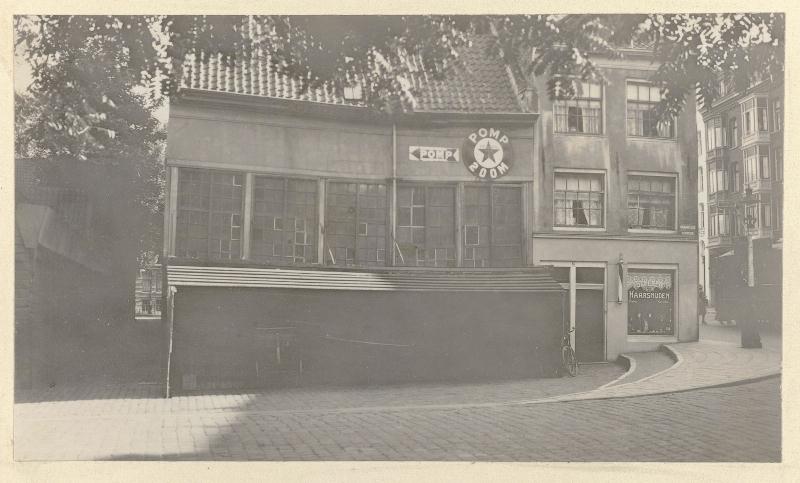 |
Fig. 8. Jacobus van Eck, Raamplein 5 and 6 (with Marnixstraat at the right), 1933. Gelatin silver print, 81 x 138 mm. Amsterdam, Koninklijk Oudheidkundig Genootschap. |
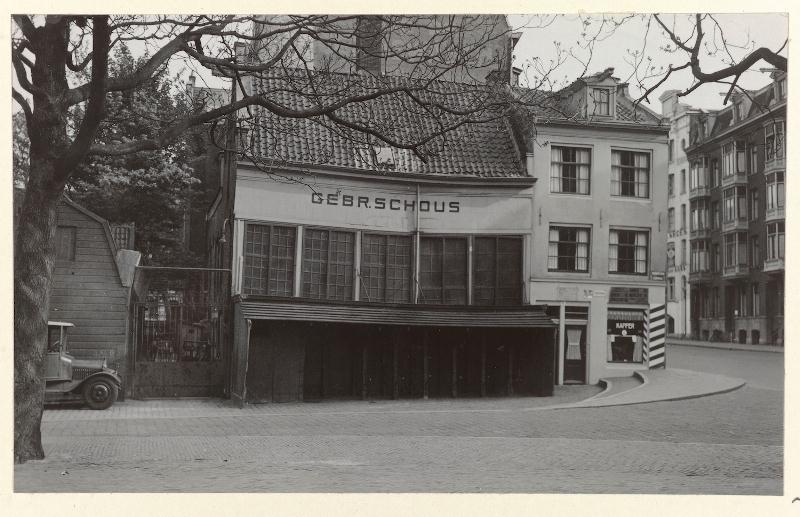 |
Fig. 9. Jacobus van Eck, Raamplein 5 and 6 (with Marnixstraat seen right), 1939. Gelatin silver print, 84 x 135 mm. Amsterdam, Koninklijk Oudheidkundig Genootschap. |
If we take a look at the photographs he made in 1917 (178 in all), it is hard to distinguish a well-defined intention. He criss-crossed the old town centre, roamed the outskirts where history had not yet been erased, but also visited the villages soon to be annexed by Amsterdam in 1921. These provided the capital with a new rural border. Many of these early photographs by Van Eck show the old border, especially on the west side of the city, like Kostverlorenvaart – a waterway where he photographed a gypsy camp (fig. 10) – and Baarsjesweg, where some windmills had not yet been demolished. This suggests that Van Eck consciously photographed what was on the brink of disappearing. But he also paid attention to things that had already changed or were in the middle of a transformation process. Among the photographs made in 1917 are the IJ, shut off from the city after Central Station was built in 1889, Spuistraat, which had been a canal until the 1860s, and Vijzelstraat while being broken up (fig. 11). There seems to be no connection between Van Eck taking up photography in 1917 and the architect H.P. Berlage’s epoch-making plan for another extension of Amsterdam (the ‘Plan Zuid’ or ‘Berlage Plan’) that was accepted in that very same year.
 |
Fig. 11. Jacobus van Eck, Vijzelstraat, with Munt Tower in the background, 1917. Gelatin silver print, 80 x 135 mm. Amsterdam, Koninklijk Oudheidkundig Genootschap. |
Even if it is hard to say what purpose Van Eck’s photographs served, most of them are of an undeniable topographic nature. That may suggest that Van Eck saw photography as a documentary means before anything else. It is very much conceivable that he simply photographed everything that was surely or possibly subject to change, without limiting himself to one specific part of Amsterdam, as he did in his book on Schans and Buitensingel. That would explain the fact that he visited both the old town centre and the new areas with his camera.
 |
Fig. 12. Jacobus van Eck, Overtoom 35, 1920. Gelatin silver print, 132 x 81 mm. Amsterdam, Koninklijk Oudheidkundig Genootschap. |
In light of his posthumously published book, his topographic collections and his own photographs, Van Eck was before all else interested in the topographic history of Amsterdam. In most photographs it is perfectly clear what the subject is: a particular building, façade, street, farm, windmill, garden, and so on (fig. 12). There are, however, several remarkable images that have a less clear topographic character. It is sometimes unclear what Van Eck had in mind when he looked at this ground glass. Take, for instance, two photographs in which the foreground is very dominant, much more so than in a photograph made merely for documentary reasons (figs. 13–14). Especially the pools on the one made near Bickersgracht bring to mind the atmospheric street scenes with puddles of water that were made in later years by André Kertész and Brassaï or – in the Netherlands – Dirk de Herder (fig. 15).
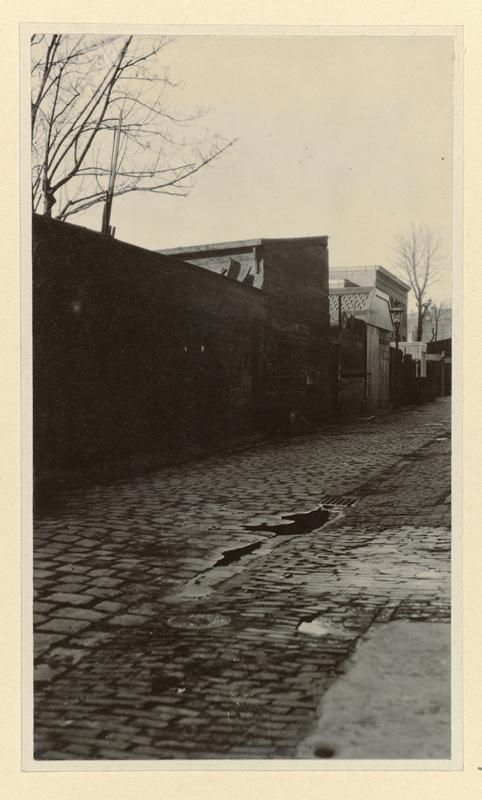 |
Fig. 13. Jacobus van Eck, Prinseneiland, with the entrance of a wharf (De Hoop + atelier Henkes), 1919. Gelatin silver print, 137 x 80 mm. Amsterdam, Koninklijk Oudheidkundig Genootschap. |
 |
Fig. 14. Jacobus van Eck, Bickersgracht, onshore side, near a wharf (De Verwachting), 1920. Gelatin silver print, 138 x 81 mm. Amsterdam, Koninklijk Oudheidkundig Genootschap. |
This remarkable dominance of the foreground is not due to indifference or clumsiness (either being a typical beginners mistake, or caused by the camera’s parallax). After all, there are two images of the same scene, one in landscape format, and one in portrait format (figs. 16–17). Their effect is very different, and we must assume Van Eck was aware of things like framing. Several times he cleverly juxtaposes old and new buildings in one photograph, implicitly suggesting how the old parts were ‘preyed upon’ (fig. 18).
 |
Fig. 16. Jacobus van Eck, Corner of Middenweg and 1e Hugo de Grootstraat, 1917. Gelatin silver print, 80 x 134 mm. Amsterdam, Koninklijk Oudheidkundig Genootschap. |
 |
Fig. 17. Jacobus van Eck, Corner of Middenweg and 1e Hugo de Grootstraat, 1917. Gelatin silver print, 134 x 80 mm. Amsterdam, Koninklijk Oudheidkundig Genootschap. |
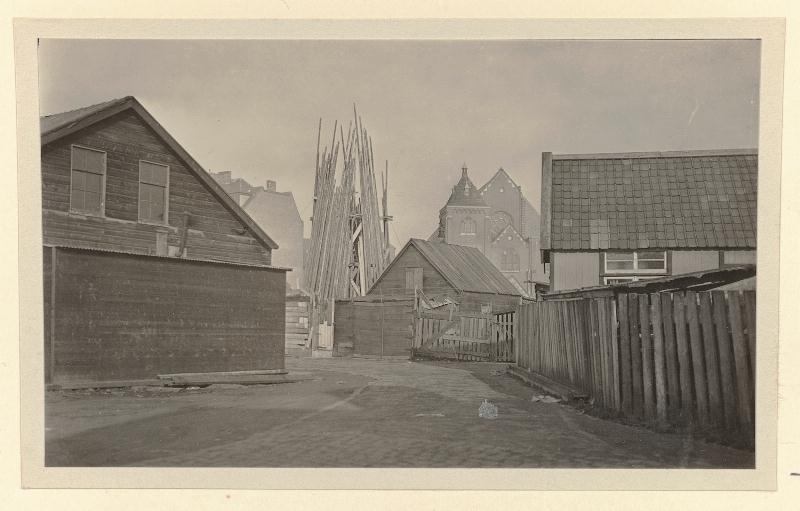 |
Fig. 18. Jacobus van Eck, Buyskade, looking towards the Prinsessekerk along Van Hallstraat, 1932. Gelatin silver print, 85 x 141 mm. Amsterdam, Koninklijk Oudheidkundig Genootschap. |
The assumption that Van Eck considered many possibilities while making his photographs is confirmed by the fact that he – at least at the beginning – had some artistic ambitions. There are, for instance, two photographs from 1917 that he printed on rough textured drawing paper (fig. 19), a method much favored in those years to enhance the artistic status of photography.
Such artistic ambitions are also visible in his various snowscapes that remind us of others made by Eilers (fig. 20), in which Van Eck took no pains to hide his somewhat detached character. One day he made a view of Keizersgracht near his own house (fig. 21). On the same occasion he photographed the view from one of his windows, of his garden and the back-house (fig. 22). These are annotated in a matter-of-fact way as ‘[Keizersgracht] seen from No. 397’ – as if it was not the place he lived for the last thirty years of his life. It is the same detachment that is characteristic of most of his writings and lectures.
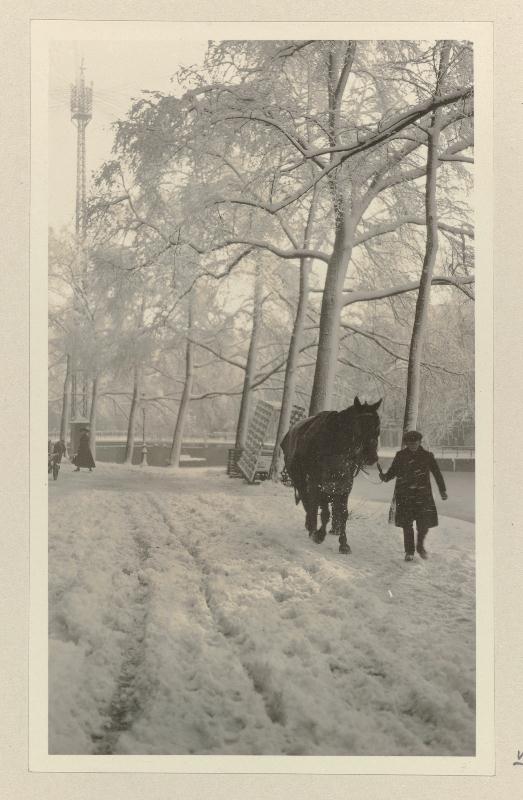 |
Fig. 21. Jacobus van Eck, Keizersgracht under the Snow, 1918. Gelatin silver print, 134 x 80 mm. Amsterdam, Koninklijk Oudheidkundig Genootschap. |
Most of Van Eck’s photographs, especially those from the 1930s, are rather cool and neutral (fig. 23). That befits the modern character of the architecture in the new neighborhoods. In 1938 Van Eck even wrote with some enthusiasm on those new blocks in the catalogue accompanying the exhibition Amsterdam 1898-1938, marking forty years of Queen Wilhelmina’s reign. The exhibition was intended to underscore how Amsterdam had expanded in those forty years. Suddenly Van Eck praised the municipality government, its plans and their consequences. According to Van Eck, the exhibition ‘aimed at giving an image of the beauty of the new neighborhoods and of the characteristic charm of the annexed villages’.[24]
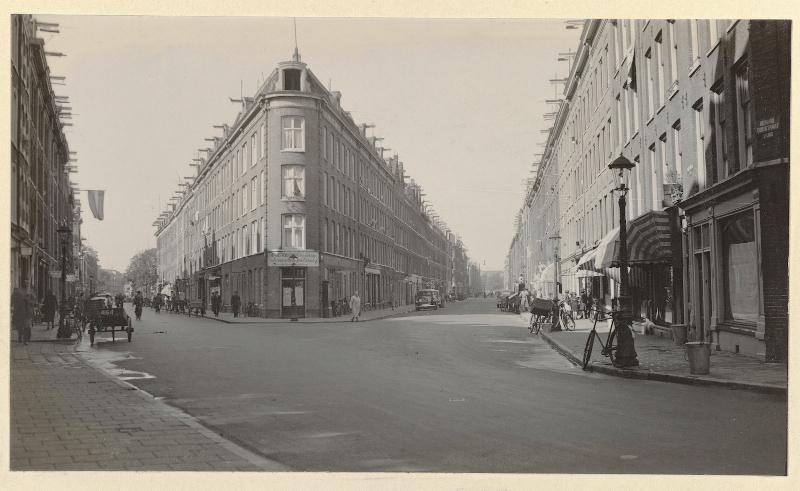 |
Fig. 23. Jacobus van Eck, Corner of Gerard Doustraat and Quellijnstraat, 1936. Gelatin silver print, 83 x 141 mm. Amsterdam, Koninklijk Oudheidkundig Genootschap. |
Apart from this catalogue text Van Eck generally complained about, among other things, the ‘long, straight, boring streets that compete in monotony with the buildings along them’, which had replaced a picturesque quarter with windmills that was anything but monotonous.[25] In a lecture given in 1935 (and published in 1936) he talked about the filling of some canals and launched some one-liners. According to Van Eck, turning these canals into streets had brought little that was good. Maybe it had been necessary, for instance to cope with the increasing amount of traffic, but he could not defend it.[26] During that lecture he remarked a few times that many buildings which once stood along water now suddenly found themselves along a street or square: ‘‘Which is beautiful along the water is not beautiful along asphalt.’[27] And: ‘The foreigner does not visit Amsterdam to see its streets but to see its canals.’[28] In De Amsterdamsche Schans en de Buitensingel Van Eck explicitly asked understanding for the considerations that led the municipality into its fateful decisions in the past, but in this 1935 lecture he could not raise such understanding himself. Maybe he was more careful in his writings than in a lecture.
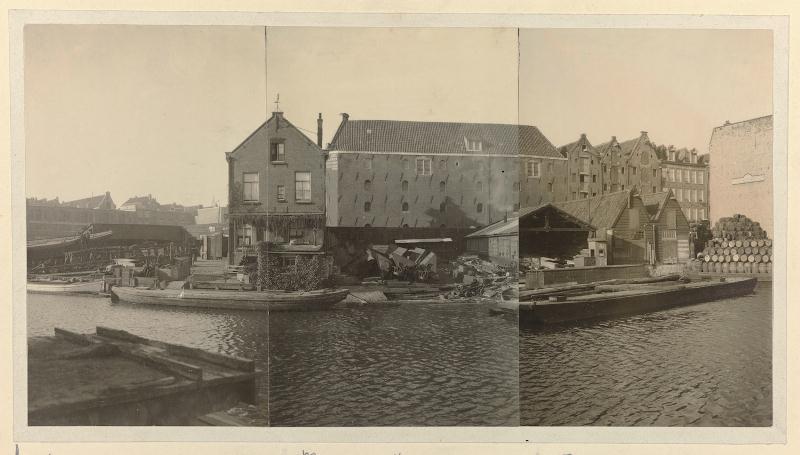 |
Fig. 24. Jacobus van Eck, A Wharf on Prinseneiland, seen from Bickerseiland, 1920. Three-part panorama, gelatin silver prints, 130 x 243 mm. Amsterdam, Koninklijk Oudheidkundig Genootschap. |
 |
Fig. 25. Jacobus van Eck, Central Station seen from Buiksloterweg, 1918. Four-part panorama. Gelatin silver prints, 78 x 504 mm. Amsterdam, Koninklijk Oudheidkundig Genootschap. |
The panoramic views undoubtedly belong to Van Eck’s most interesting photographs. He made these from two or more separate images pasted together (fig. 24). There is more behind these panoramas than merely Van Eck’s enjoyment in making them. In 1918 he made a four-part panorama of Central Station seen from the north (fig. 25). Van Eck came back many years later, in 1935, undoubtedly for the purpose of his lecture ‘The beauty of Amsterdam before and after the IJ landfill’.[29] Van Eck probably wanted to show how drastically and irreversibly the long station cut off the city from the IJ, however much the two had been inseparable for centuries. Van Eck had been one of the many opponents of the plan to build the new station there, instead of at some other spot.[30] This controversy was one of the hottest in the second half of the 19 th century, when Amsterdam changed and expanded radically, previously having stayed within the walls built in the 1660s. Not only did Amsterdam leap over its walls, but the side of the city facing the open water also changed drastically. The panoramic views of Central Station picture one of the modern additions that – according to Van Eck – disfigured the city most. When the lecture was printed in 1936, Van Eck included one of his panoramas (fig. 26).[31] The image is cropped so much that hardly anything else is visible besides the roof over the station’s platforms. Treated this way, the photograph convincingly demonstrates that the station indeed separates the city from the water. In some of his other prints, the cropping is even starker, so that that the roof appears as a huge, grayish wall that blocks the view (fig. 27).
Conclusion
The 1,700 or so photographs Van Eck left to the KOG in 1946 are a valuable addition to the ‘photographic image of old Amsterdam’. This is even more so, as the neighborhoods that were built since the last quarter of the 19 th century have not been thoroughly recorded photographically. Many a photographer preferred the old, picturesque town centre and ignored the newer neighbourhoods. Breitner liked photographing construction sites, but only as long as the piles were being driven and workers and horses were still working in the sand and mud. As soon as the foundations were complete and the building proper began, Breitner disappeared. Van Eck did not have much feeling for new construction either, but he managed to overcome his aversion and depicted whatever was disappearing, changing, or being built. The fact that his interest was not artistic but documentary, antiquarian, topographic and historic made it possible for him to rise above his prejudices.
That same topographic interest enabled Van Eck to introduce some nuance in the common contrast between ‘then’ /good and ‘now’/bad. He focused his research on the long transitional period between about 1800 and the beginnings of the 20 th century, and wanted to own photographs from all periods, either made by himself or made by others. He did, however, sometimes use his photographs – subtly, quasi-off-hand – to substantiate his objections to, for instance, the location chosen to build Central Station. He did so only in a very subtle way.
Depicting both the scenes of which he had such fond memories from his youth and the modern urban expansions he judged so critically, Van Eck’s photographs provide us with a less one-sided view of how Amsterdam looked and developed than was the case with people like Breitner. Not all of Van Eck’s photographs are visually powerful, but many of them bear witness to his eye for lighting, chiaroscuro, and composition. His photographs are important because of both their quantity and quality. No individual inter-war photographer’s archive in the Amsterdam City Archives’s image bank contains more photographs than Van Eck’s.
To be sure, Van Eck did not possess the same sharp eye and artistic vision Breitner had. Neither did he have such artistic ambitions as Bernard Eilers (who was hardly interested in the buildings as such, or their occupants). Van Eck does, however, relativize the image these two gave of Amsterdam. Of the three best-known photographers of Amsterdam cityscapes, Jacob Olie is the most congenial to Van Eck. They shared a common interest in the urban development of their home city, and they in part photographed the same scenes, like Amstelveld, Zandhoek and Boerenwetering. They have both depicted the old town centre, the outskirts, and the modern additions.[32].
Van Eck’s photographs are so important, because no one else has so extensively depicted the radical changes that Amsterdam underwent in the years between 1917 and 1940. Much has completely disappeared since, like the buildings on Raamplein (figs. 9, 10). Although more than a decade passed between the moment Jacob Olie died and Van Eck took up photography, the latter is – more than anyone else – a worthy successor to Olie as chronicler of a continuously changing city. If – and how – Van Eck fits in a larger and broader tradition of documenting changes that took place in the world around us is to be explored elsewhere. It falls outside the scope of this article, which is meant to introduce Van Eck for the very first time, as a collector turned photographer. He was one of the many photographers who were either commissioned to, or set themselves the task of trying to ‘freeze’ those changes pictorially. The introduction of photography in 1839 more or less coincided with an increase in the awareness that many of the modern social, political and economic developments were bringing about radical transformations of life, labour, landscape and cities. Many photographers started making this transformation process their subject, or were commissioned to do so. These photographers include people like Thomas Annan and Charles Marville, who photographed extensively in the cities where they lived (Glasgow and Paris, respectively), and who were commissioned to do so by municipal authorities. Of all the photographers who tried to preserve what was slipping away under their eyes, Eugène Atget is perhaps the best-known, working on his own and selling his photographs to whomever wanted them. In Atget’s case, the subject was a Paris that was already being radically transformed at the time of his birth in 1857. Other photographers we immediately think of are those involved in the French Mission Héliographique, or those working for institutions which aim at preserving architectural cultural heritage, like the Architectural Photographic Association in England. If we do not limit ourselves to photographs of urban environments, we could also point to Edwin S. Curtis, who photographed ‘a vanishing race’ (the North American Indians), August Sander, who tried to capture a whole people (the Germans) in one body of photographs, or Peter Henry Emerson, who as a naturalist was very much interested in the customs and ways of life in certain English regions, and gave us both written and pictorial accounts of them. But even if we do limit ourselves to urban environments or big cities (from Paris and London to Amsterdam and Antwerp), Van Eck’s photographs could very well be compared to many others. After all, photography was soon considered a very suitable means of arresting all ‘movement’ and change, whether the motivation behind that was modern and progressive, or a nostalgic vision. The list of photographers we could associate with the concept of change and how to relate to that phenomenon is a very long one and – apart from those already mentioned – includes Walker Evans, Aaron Siskind, and many more American photographers. Photography is, after all, about making time stand still. Many amateurs have been part of that large ‘movement’, and it would be interesting to put Van Eck’s work into perspective by establishing the role it played and its character.[33].
CV
Hans Rooseboom (1966) is Curator of Photography at the Rijksmuseum Amsterdam. In 2006 he earned his Ph.D. with a study on the socio-economic position of Dutch 19th-century professional photographers (De schaduw van de fotograaf, commercial edition Leiden 2008, with a summary in English). Among his most recent publications is What’s Wrong with Daguerre? Reconsidering old and new visions on the invention of photography (Amsterdam 2010). He is one of the editors of Depth of Field.↑
Notes
1. Research into Van Eck’s photographs has been conducted by both the author of this article and Ester Wouthuysen.↑
2. The photographs made by Olie, Breitner, and Eilers have been the subject of many books and exhibitions in recent decades. For Olie, see Van Eeghen 1960, and Van Veen 2000, among others. For Breitner see: Hefting/Quarles van Ufford 1966, Osterholt 1974, Hefting 1989, Bergsma/Hefting 1994, Van Veen 1997, Gordijn/Van de Laar/Rooseboom 2001, Keijer 2004, Rooseboom 2011a, Rooseboom 2011b, Bergsma 2012, and others. For Bernard Eilers see: Markerink/Hekking 1979, Van Veen 2003, and others.↑
3. Hans Rooseboom, ‘George Hendrik Breitner: the photographer’, http://breitnerenglish.rkdmonographs.nl/between-tradition-and-modernism. (accessed on 30 November 2012)↑
4. For Eilers’s aesthetics, see especially Van Veen 2003, pp. 57-66. ↑
5. Van Veen 2000, pp. 59, 62-66. ↑
6. Rooseboom/Wouthuysen 2002, Scherpenisse 2006, Scherpenisse 2008. ↑
7. From 1914 until his death Van Eck was a member of the KOG, in which he held many administrative functions. The photographic prints made from his own negatives and left by him to the KOG have been accessible since 2007 on the Amsterdam City Archives’s image bank. There one can also find the drawings Van Eck collected. Prints that were made at a later date from negatives Van Eck had not printed himself are not included. Photographs made by others and owned by Van Eck are not (or rarely) included either. Some 1,700 photographs by Van Eck are accessible on this image bank. In the past another number (1,200) have sometimes been mentioned (Gerlagh/Heijbroek 1995, p. 202). This can probably be traced back to the obituary written by A.M. van der Waal, who was a friend and fellow-collector of topographic images (Van de Waal 1946/1947, p. 77). ↑
8. The prints, maps, and books Van Eck had collected were not left to the KOG, but auctioned. ↑
9. Heijbroek/Gerlagh 1995, pp. 199-201. Cf Van Veen 2007, pp. 252-256.↑
11. De Telegraaf 23 November 1943; Gerlagh/Heijbroek 1995, p. 202.↑
12. Vermeer 2010, p. 9. ↑
13. Feddes 2012, p. 136. See also Aerts/De Rooy 2006, pp. 90-91.↑
14. See for instances the plans included in Van Eck 1948 and Aerts/De Rooy 2006, pp. 90-91↑
15 Van Eck 1948. It seems that only in his last years did Van Eck get around to digesting all the data he gathered and forging it into a book. In 1946 Van de Waal wrote: ‘Van Eck’s firm came to a standstill almost completely during World War II. As a consequence, he had a lot of spare time on his hands. A plan he had cherished for a long time was now carried out. He began writing down – on 500 folio sheets of paper – the history of Schans and Buitensingel and the surrounding neighborhoods’ (Van de Waal 1946/1947, p. 80: ‘Een reeds lang gekoesterd plan kwam tot uitvoering. Op ruim 500 folio vellen, in potlood geschreven, heeft hij de geschiedenis vastgelegd van de Schans en den Buitensingel met de omliggende buurten’). Van Eck mentioned the existence of a manuscript in his will (dated August 1942), but that was probably not yet completed. In the introduction to an auction catalogue (Amsterdam, G. Theod. Bom en Zoon, 4-7 December 1946) Van de Waal wrote about a manuscript left by Van Eck. Van Eck indeed never succeeded in getting beyond a manuscript version, and it was Van de Waal who had it typed out (witness the fact that the typist at least once misread a street name – Van Eck’s handwriting was rather awful – and Van de Waal corrected it by hand (KOG Hs 59 C, p. 353). Neither Van Eck or Van de Waal would have had made such a mistake.) ↑
16. Van Eck 1948, p. 336. ↑
17. Van Eck 1948, p. 3: ‘De Buitensingel was voor mij in mijn jeugd de uitverkoren wandelweg; het was mij immer een genot langs de vele paden te zwerven en mij te verlustigen in het aanzicht van de robuuste molens omgeven door de veelal keurig onderhouden bebouwing van de molenaars, de aardige arbeiderswoningen en de karakteristieke buitenverblijven, half verscholen onder opgaand hout, met hun moes- en siertuinen. […] Met weemoed zag ik hoe hier sloot na sloot werd gedempt en de molens, woningen en optrekjes onder sloopers handen vielen, waarbij de tuinen werden verwoest en ooftboomen, struiken en sierplanten aan vernietiging werden prijsgegeven.’↑
18 For an overview of all fillings, see Feddes 2012, p. 112. ↑
19. Examples of books in which old and modern photographs are juxtaposed to make clear how radically Amsterdam had changed include Kouwenaar 1940 and Moritz 1942. In Kouwenaar 1940 several photographs by Van Eck are included (without the photographer being credited). ↑
20. Van Eck 1948, p. 4: ‘Toch zijn de jaren, waarin de wisselingen hebben plaats gevonden voor hen, die de veranderingen niet hebben mede gemaakt, van groot belang. Men moet zich een voorstelling kunnen maken van het inzicht der toenmalige regeerders, de eischen die werden gesteld aan de stadsuitbreiding en van den toen heerschenden geest om alles leelijk te vinden wat oud was, daarentegen toe te juichen alles wat nieuw werd gemaakt, hoe leelijk en bekrompen het ook was.’↑
21. Van Eck 1936, pp. 55-72. Several of Van Eck’s photographs are included in Kouwenaar 1940, where the author deliberately printed a photograph of the old situation and one of the present situation on the same page. ↑
22. Van de Waal 1946/1947, p. 79.↑
23. Reading De Amsterdamsche Schans en de Buitensingel and the dossiers that Van Eck compiled, one will see how meticulously Van Eck has documented all changes that took place during his lifetime. One can only admire all the attention and time Van Eck devoted to the subject of his researches. ↑
24. Van Eck 1938, p. 8: ‘Getracht is met de tentoonstelling “Amsterdam 1898-1938” een beeld geven van de schoonheid der nieuwe stadswijken en van de karakteristieke bekoring der geannexeerde dorpen’.↑
25. Van Eck 1948, p. 73. ↑
26. The canals were once used for transport, a source of water for both drinking and firefighting, and as an open sewer, but they had increasingly lost these functions in the course of time. For the functions the canals may still have, see Feddes 2012, pp. 105-131. ↑
27. Van Eck 1936, p. 67: ‘Wat schoon en mooi met water is, is het niet met asphalt’.↑
28. Van Eck 1936, p. 71: ‘De vreemdeling komt niet naar Amsterdam om haar straten maar wel om haar grachten’.↑
29. Van Eck 1936.↑
30. Van Eck 1936, pp. 57-61 (p. 57: ‘… een verminking die het begin zou zijn van een lange reeks vernietigingen van het stadsschoon’). Van de Waal 1946/1947, p. 80. For the Central Station ‘case’, see Feddes 2012, among others. ↑
31. Van Eck 1936, between pp. 60-61, afb. 2. ↑
32. For Olie’s opinion on contemporary architecture, see Van Veen 2000, pp. 62-63. ↑
33. One publication that is worth reading in this respect is Elizabeth Edwards, The Camera as Historian. Amateur Photographers and Historical Imagination, 1885-1918, Durham/London 2012, even if it focuses on photographs made in rural UK and ends at the time Van Eck had just started photographing. ↑
Literature references
Remieg Aerts en Piet de Rooy (eds.) 2006, Geschiedenis van Amsterdam, 1813-1900. Hoofdstad in aanbouw, Amsterdam.
Rieta Bergsma 2012, G.H. Breitner. Vijf studies over een Amsterdamse schilder en zijn tijd, s.l.
Rieta Bergsma and Paul Hefting (eds.) 1994, George Hendrik Breitner 1857-1923. Schilderijen, tekeningen, foto’s, Bussum.
Mattie Boom 1995, ‘Een geschiedenis van het gebruik en verzamelen van foto’s in de negentiende eeuw’, in J.F. Heijbroek and R. Meijer (red.), Voor Nederland bewaard. De verzamelingen van het Koninklijk Oudheidkundig Genootschap in het Rijksmuseum, Leids Kunsthistorisch Jaarboek dl. 10, Baarn, pp. 273-294.
J. van Eck [1936], ‘De schoonheid van Amsterdam voor en na het dempen’, Koninklijk Oudheidkundig Genootschap. Jaarverslag …, pp. 55-72.
J. van Eck 1938, Amsterdam 1898-1938. Catalogus van de tentoonstelling in het Museum Fodor 2 September-15 October 1938 ter gelegenheid van het 40-jarig regeeringsjubileum van Hare Majesteit de Koningin, Amsterdam.
J. van Eck 1948, De Amsterdamsche Schans en de Buitensingel, Amsterdam.
I.H. van Eeghen 1960, Amsterdam in de tweede helft der XIXe eeuw, gezien door Jacob Olie Jacobsz, Amsterdam.
Fred Feddes 2012, 1000 jaar Amsterdam. Ruimtelijke geschiedenis van een wonderbaarlijke stad, Bussum.
Bert Gerlagh and J.F. Heijbroek 1995, ‘De Atlas Amsterdam’, in J.F. Heijbroek en Renate Meijer (red.), Voor Nederland bewaard. De verzamelingen van het Koninklijk Oidheidkundig Genootschap in het Rijksmuseum, Leids Kunsthistorisch Jaarboek dl. 10, Baarn, pp. 199-220.
Aad Gordijn 2001, Paul van de Laar en Hans Rooseboom, Breitner in Rotterdam. Fotograaf van een verdwenen stad, Bussum.
Paul Hefting 1989, De foto’s van Breitner, Den Haag.
Paul Hefting and C.C.G. Quarles van Ufford 1966, Breitner als fotograaf, Rotterdam.
Kees Keijer 2004, Breitners Amsterdam. Schilderijen en foto’s, Bussum.
D. Kouwenaar 1940, Amsterdam 1900-1940, Amsterdam.
Cary Markerink and Sybrand Hekking 1979, Bern. F. Eilers, Den Helder.
B. Moritz 1942, Ontsiering [van] stad en land, Amsterdam.
A.B. Osterholt 1974, Breitner en zijn foto’s, Amsterdam.
Hans Rooseboom 2011, George Hendrik Breitner. The Photographer, http://breitnerenglish.rkdmonographs.nl/george-hendrik-breitner-the-photographer (accessed on 20 nov 2012)
Hans Rooseboom 2011, ‘Movement Studies in an Urban Setting. The Photographs of George Hendrik Breitner’, in: Elizabeth W. Easton (ed.), Snapshot. Painters and Photography, 1888-1915, New Haven/London, pp. 83-8.
Hans Rooseboom and Ester Wouthuysen 2002, G.H. Heinen. Panorama’s en stadsgezichten – Amsterdam in 1894, Amsterdam.
Peter Scherpenisse 2006, Fotocollectie J.L. Scherpenisse. 835 beelden van Authentiek Amsterdam, 1905-1913, Amsterdam.
Peter Scherpenisse 2008, Amsterdam een eeuw geleden, Arnhem.
Anneke van Veen (ed.) 1997, G.H. Breitner, fotograaf en schilder van het Amsterdamse stadsgezicht, Amsterdam/Bussum.
Anneke van Veen 2000, Jacob Olie Jbz (1834-1905), Amsterdam.
Anneke van Veen 2003, Bernard F. Eilers (1878-1951), Amsterdam.
Anneke van Veen 2007, ‘“I saw a plastic bag”. Photography and Urbanism, 1852-2000’, in Flip Bool et al., Dutch Eyes. A critical history of photography in the Netherlands, Zwolle, pp. 247-289.
Gerrit Vermeer et al. 2010, Historische gids van Amsterdam. Stadsuitbreidingen 1860-1935, Amsterdam.
A.M. van de Waal [1946-1947], ‘Ter nagedachtenis Jacobus van Eck, 23 November 1873 – 16 September 1946’, Koninklijk Oudheidkundig Genootschap. Jaarverslagen, pp. 77-81.


